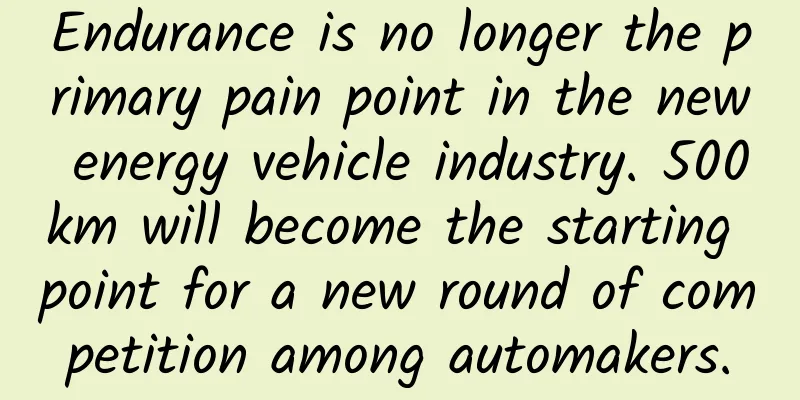Endurance is no longer the primary pain point in the new energy vehicle industry. 500km will become the starting point for a new round of competition among automakers.

|
In recent years, the new energy vehicle industry has been developing rapidly. Not only traditional car companies have made great efforts, but also various new car-making forces have emerged. The country has also adopted a series of policies to spare no effort to support this industry. However, although new energy vehicles have made great progress, they are still highly dependent on government subsidies and cannot completely rely on their own product performance to win market favor. The insufficient range and long charging time of new energy vehicles make many consumers worried when considering new energy vehicles. If new energy vehicles want to develop independently and rely on market forces to grow and develop, they must increase their range and reduce charging time. Troubles that can't run away Tesla is the benchmark in the new energy vehicle industry. There are many reasons for Tesla's success, and the basic performance of the car is the most basic premise. Tesla Model X has a range of 383-475km. Model 3 can reach 499km after optional long-range battery kit. Model S has a range of 443-542km, and the flagship model P100D has a maximum range of 542km. Recently, domestic mid-range electric vehicles have made great progress in cruising range. The Trumpchi GE3 530 recently launched by GAC New Energy has a maximum cruising range of 530km. The factors that limit the range of new energy vehicles are mainly the "three electrics" - batteries, motors, and electronic controls. Among them, batteries are the top priority. Due to cost and space constraints, new energy vehicles cannot increase the number of batteries indefinitely. Therefore, improving the energy density of batteries is very critical. Tesla uses cylindrical batteries with the highest energy density to improve energy density. The redesigned electric vehicle platform allows the car to add as many battery packs as possible. Tesla has repeatedly claimed that its energy density ranks first in the industry, and its excellent endurance performance allows it to compete with fuel vehicles. The Trumpchi GE3 530 launched by GAC New Energy also uses an electric vehicle-specific platform and the latest generation of ternary battery cell technology from CATL, which greatly improves the energy density. Combined with the lightweight design of the battery, the energy density of the Trumpchi GE3 battery system has reached 160Wh/kg; the electronic control technology used - IGBT technology maximizes the saving of precious electricity and further improves the driving range. In February this year, the Ministry of Finance issued the "Notice on Adjusting and Improving the Financial Subsidy Policy for the Promotion and Application of New Energy Vehicles", further improving the conditions for the issuance of subsidies for new energy vehicles. According to the latest policy, in order to enjoy the highest subsidy, new energy vehicles must have a range of more than 400km, a battery density of 160Wh/kg, and an energy consumption per 100km of 25% higher than the threshold. The increase in subsidy standards forces companies to continuously improve the performance of new energy vehicles and gradually increase their market competitiveness relative to fuel vehicles; at the same time, it will also eliminate a number of backward production capacities and promote the concentration of resources in capable companies. At present, the driving range of advanced new energy vehicles at home and abroad has exceeded 500 kilometers, which reflects the rapid development of the technology in the new energy vehicle industry. As more and more companies cross this threshold, the competition in the driving range of new energy vehicles will become more intense. The competition track for the driving range of new energy vehicles has gradually started with 500km, which will greatly increase the market's acceptance of new energy vehicles. Anxiety that fills you up The development of new energy vehicles is not only restricted by its own technical conditions, but also by charging infrastructure and charging technology. The reason why many consumers do not consider new energy vehicles when buying a car is that there are few charging piles and charging is inconvenient. Charging speed is another major concern for new energy vehicles. At present, electric vehicles are mainly charged by contact charging, which is divided into two types: AC slow charging and DC fast charging. Slow charging is mainly used in homes and workplaces, while fast charging is mainly used in public facilities and highways. Now it takes more than half an hour for fast charging to charge 80%. This has brought great inconvenience to the promotion of new energy vehicles. The current wireless charging technology is still very immature, but high-power charging piles are expected to solve the problem of slow charging. High-power charging places high demands on the battery's thermal management system. Some car companies have now solved this problem well by improving the ability to control battery temperature and adapting to high-power charging to increase charging speed. Trumpchi GE3 530 did not abandon the battery temperature control system in order to improve the battery energy density. Its third-generation intelligent temperature control system regulates the battery temperature through the liquid temperature control circulation inside the battery pack, which can keep the battery in a suitable temperature range and always maintain an efficient working state. High-power charging also has high requirements for charging piles, but the existing charging piles are not only insufficient in number, low in power, but also have chaotic standards. This makes it impossible for new energy vehicles to be used in reality even if they meet the technical requirements for high-power charging. Gu Huinan, general manager of GAC New Energy, said that the realization of fast charging of new energy vehicles currently depends on the construction of fast charging stations. The promotion of new energy vehicles not only requires the efforts of automobile companies, but also depends on the progress and improvement of upstream and downstream supporting industries. As a winner of Toutiao's Qingyun Plan and Baijiahao's Bai+ Plan, the 2019 Baidu Digital Author of the Year, the Baijiahao's Most Popular Author in the Technology Field, the 2019 Sogou Technology and Culture Author, and the 2021 Baijiahao Quarterly Influential Creator, he has won many awards, including the 2013 Sohu Best Industry Media Person, the 2015 China New Media Entrepreneurship Competition Beijing Third Place, the 2015 Guangmang Experience Award, the 2015 China New Media Entrepreneurship Competition Finals Third Place, and the 2018 Baidu Dynamic Annual Powerful Celebrity. |
<<: Why the next O2O giant may be born in the incredible India
>>: WM Motor is caught in a cancellation storm, with a product cancellation rate of up to 30%
Recommend
Tips for attracting new customers and retaining customers from Pinduoduo/Meituan and others!
High-quality cases cannot be hidden. I will updat...
How much does Cordyceps sinensis cost per gram?
How much does Cordyceps sinensis cost per gram? T...
Huo Qubing's Douyin SEO course, Douyin SEO optimization is very popular, and the bonus period contains unlimited wealth
Huo Qubing's Douyin SEO course, Douyin SEO op...
The second hero who knocked on the door of space should not be forgotten
On August 6, 1961, Yuri Gagarin was awakened from...
Seven Xcode tips every developer should know
If you want to do your work well, you must first ...
Great Wall Motors: In November 2023, Great Wall Motors sold 122,849 vehicles, a year-on-year increase of 40.3%
Great Wall Motors announced its group sales in No...
Can it snow in your eyes? What does the inside of a firework look like? Check out the 10 most interesting pictures of the day
Issue 1204 @Embarrassing Encyclopedia Have you ev...
Why are those medicines that have grown with us gradually disappearing?
Recently, the State Drug Administration issued th...
Stealing things and beating people, why are the monkeys in Mount Emei so "brutal"?
I don't know when it started, but cursing the...
5 marketing strategy ideas to build a brand with lasting competitiveness
Whether it is as small as a promotional activity ...
A "new" chemical element, want to "get into the pit" of the periodic table? It's not that easy!
Recently, researchers from the Institute of Moder...
The autumn semester is coming! How much do you know about the prevention and treatment of "pink eye"?
===========================================...
What can domestic new energy vehicles rely on to take a bite of the huge cheese of the European market?
For quite a long time, domestic automobile manufa...
Photography, beauty, which advertising materials are timeless and creative?
I wonder if you often receive such advertising co...
You can quickly restore your energy in 10 minutes, and you can do it anytime and anywhere. If you don’t know this method, you will miss out.
If I don't take a nap, I'm afraid I'l...









